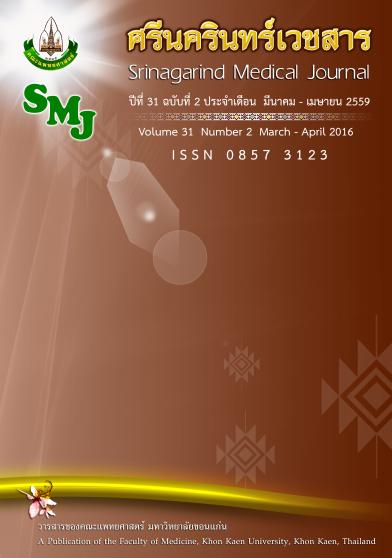Quality Assessment of Chronic Pain Management in Srinagarind hospital
Keywords:
Quality assessment, Chronic pain management, Pain management indexAbstract
Background and Objective: Chronic pain could be caused causes from both cancer and non-cancer in origin. Pain is the common symptom in patients with advanced cancer. Pain can affect many organ systems and also interference with a psychological problem. Effective pain management improved the quality of life in chronic pain patients. This study aims to assess the quality management of chronic pain control from primary physicians and pain unit from the department of Anesthesiology, faculty of Medicine, Khon Kaen university.
Methods: We retrospectively studied the chronic pain records of pain unit in all admitted and consulted patients for a peried of seven years during January 2004 to December 2010. The demographic data, pain characteristics (causes and types of pain, pain symptoms and locations of pain), quality of chronic pain management use pain management index (PMI) for primary physicians and using the quality of life assessment for pain unit, pain intensities before and after treatment, side effects and status of patient before discharge were assessed. We used descriptive analysis and compared the data with dependent T-test and one-way ANOVA multiple comparisons (statistical significance at the p < 0.05) with SPSS (version 19.0).
Results: Totally, 51.4% were females out of 352 patients and the mean age were about 41.5 + 19.2 years old. The most of chronic pain causes was cancer (47.2 %) especially in gastrointestinal tract (GI tract) cancer (16.2%). Burning pain was the most complaint of the pain symptoms (13.4%). Negative PMI (PMI -1 to –3) was 16.2% and mostly found in non-cancer pain patients (40.3%). The chronic pain patients were significantly improved both their highest and lowest pain scores and also a better quality of life in 1 week after treated by the pain unit (p<0.001). Before pain consults, 49.4% of total patients had medication side effects and then decreased to 17.3% after consulted for 1 week. The most side effect was constipation (5.4%). The pain improvement was the most common of the status before discharge.
Conclusion: This study suggests that quality of chronic pain management from pain unit improves the quality of life and pain relief within one week.



